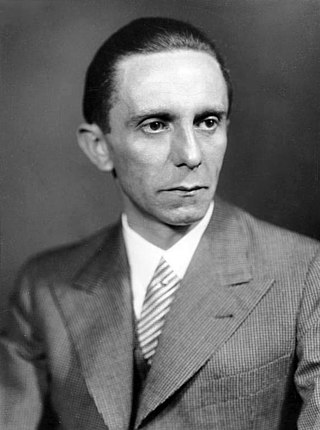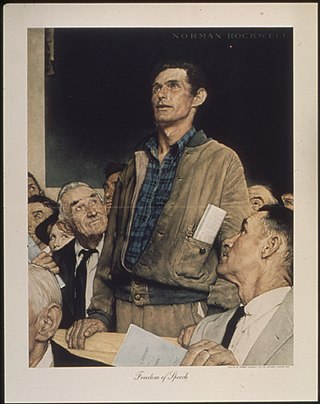
War film is a film genre concerned with warfare, typically about naval, air, or land battles, with combat scenes central to the drama. It has been strongly associated with the 20th century. The fateful nature of battle scenes means that war films often end with them. Themes explored include combat, survival and escape, camaraderie between soldiers, sacrifice, the futility and inhumanity of battle, the effects of war on society, and the moral and human issues raised by war. War films are often categorized by their milieu, such as the Korean War; the most popular subjects are the Second World War and the American Civil War. The stories told may be fiction, historical drama, or biographical. Critics have noted similarities between the Western and the war film.

Why We Fight is a series of seven propaganda films produced by the US Department of War from 1942 to 1945, during World War II. It was originally written for American soldiers to help them understand why the United States was involved in the war, but US President Franklin Roosevelt ordered distribution for public viewing.

The Committee on Public Information (1917–1919), also known as the CPI or the Creel Committee, was an independent agency of the government of the United States under the Wilson administration created to influence public opinion to support the US in World War I, in particular, the US home front.

Arthur Szyk ; June 3, 1894 – September 13, 1951) was a Polish-born Jewish artist who worked primarily as a book illustrator and political artist throughout his career. Arthur Szyk was born into a prosperous middle-class Jewish family in Łódź, in the part of Poland under Russian rule in the 19th century. An acculturated Polish Jew, Szyk always proudly regarded himself both as a Pole and a Jew. From 1921, he lived and created his works mainly in France and Poland; in 1937 he moved to the United Kingdom. In 1940, he settled permanently in the United States, and was granted American citizenship in 1948.

The propaganda used by the German Nazi Party in the years leading up to and during Adolf Hitler's dictatorship of Germany from 1933 to 1945 was a crucial instrument for acquiring and maintaining power, and for the implementation of Nazi policies.

Prelude to War is the first film of Frank Capra's Why We Fight film series commissioned by the Office of War Information (OWI) and George C. Marshall. It was made to educate American troops of the necessity of combating the Axis powers during World War II based on the idea that those in the service would fight more willingly and ably if they knew the background and the reason for their participation in the war. The film was later released to the general American public as a rallying cry for support of the war.

Pennsylvania was the site of many key events associated with the American Revolution and American Revolutionary War. The city of Philadelphia, then capital of the Thirteen Colonies and the largest city in the colonies, was a gathering place for the Founding Fathers who discussed, debated, developed, and ultimately implemented many of the acts, including signing the Declaration of Independence, that inspired and launched the revolution and the quest for independence from the British Empire.

The United States home front during World War II supported the war effort in many ways, including a wide range of volunteer efforts and submitting to government-managed rationing and price controls. There was a general feeling of agreement that the sacrifices were for the national good during the war.

During American involvement in World War II (1941–45), propaganda was used to increase support for the war and commitment to an Allied victory. Using a vast array of media, propagandists instigated hatred for the enemy and support for America's allies, urged greater public effort for war production and victory gardens, persuaded people to save some of their material so that more material could be used for the war effort, and sold war bonds.

Britain re-created the World War I Ministry of Information for the duration of World War II to generate propaganda to influence the population towards support for the war effort. A wide range of media was employed aimed at local and overseas audiences. Traditional forms such as newspapers and posters were joined by new media including cinema (film), newsreels and radio. A wide range of themes were addressed, fostering hostility to the enemy, support for allies, and specific pro war projects such as conserving metal and growing vegetables.

The Four Freedoms is a series of four oil paintings made in 1943 by the American artist Norman Rockwell. The paintings—Freedom of Speech, Freedom of Worship, Freedom from Want, and Freedom from Fear—are each approximately 45.75 by 35.5 inches, and are now in the Norman Rockwell Museum in Stockbridge, Massachusetts. The four freedoms refer to President Franklin D. Roosevelt's January 1941 Four Freedoms State of the Union address, in which he identified essential human rights that should be universally protected. The theme was incorporated into the Atlantic Charter, and became part of the Charter of the United Nations. The paintings were reproduced in The Saturday Evening Post over four consecutive weeks in 1943, alongside essays by prominent thinkers of the day. They became the highlight of a touring exhibition sponsored by The Post and the U.S. Department of the Treasury. The exhibition and accompanying sales drives of war bonds raised over $132 million.

American music during World War II was considered to be popular music that was enjoyed during the late 1930s through the mid-1940s.

Bernard Perlin was an American painter. He is primarily known for creating pro-war art during World War II and magic realism paintings of urban American life.

World War I was the first war in which mass media and propaganda played a significant role in keeping the people at home informed on what occurred at the battlefields. It was also the first war in which governments systematically produced propaganda as a way to target the public and alter their opinion.

Propaganda is a form of communication that aims to shape people's beliefs and behaviors. It is typically not impartial. It is often biased, misleading, or even false to promote a specific agenda or perspective. Propagandists use various techniques to manipulate people's opinions, including selective presentation of facts, the omission of relevant information, and the use of emotionally charged language.
Food Will Win the War is an American short animated film produced by Walt Disney Studios and released on July 21, 1942, seven months and two weeks after the December 7, 1941 attack on Pearl Harbor. The 6-minute short was one of a series of animated films produced by Disney during the war as part of a propaganda campaign. The animation was produced on order of the Department of Agriculture, first and foremost to educate about the importance of American agriculture in the war effort and also, to offset fears and panic of Americans who thought too many supplies were being sent overseas. The film was a morale boosting production, in the hope of improving public mood and opinion about sacrifice for the war effort.

During World War II, Morocco, which was then occupied by France, was controlled by Vichy France from 1940 to 1942 after the occupation of France by Nazi Germany. However, after the North African campaign, Morocco was under Allied control and thus was active in Allied operations until the end of the war.

Propaganda in World War II had the goals of influencing morale, indoctrinating soldiers and military personnel, and influencing civilians of enemy countries.
WWII propaganda in the southern United States was a complex interplay of wartime messages and regional racial dynamics. As the United States government disseminated information to bolster the war effort against the Axis Powers, the unique social landscape of the American South led to distinct consequences. The propaganda campaigns not only fueled nationalism but also catalyzed social changes, contributing to racial tensions and laying the groundwork for future civil rights movements.

















